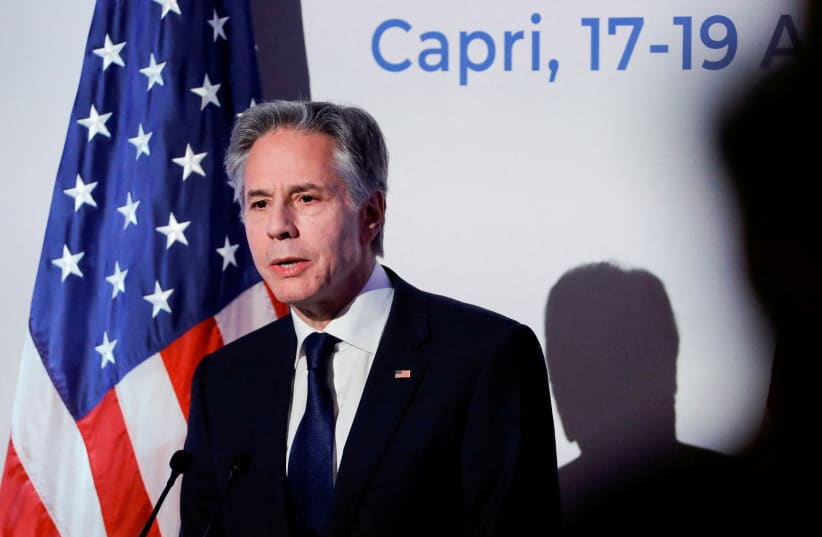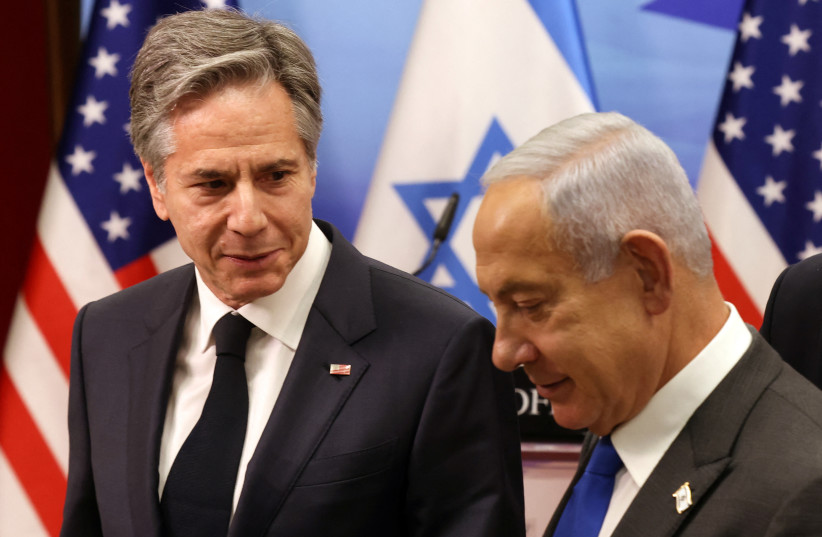If US-Israel relations are like a roller-coaster ride, then US Secretary of State Antony Blinken’s current visit comes as the car begins a gradual ascent after a steep dip.
This is Blinken’s eighth trip to Israel since October 7. Following two visits in October immediately after Hamas’s attack, he has visited and met with Prime Minister Benjamin Netanyahu and the war cabinet about every month since.
Blinken’s last visit was on March 22, a time of heightened tension between Israel and the US over the Gaza war, with the US – just a couple days after that visit – allowing the passage in the UN Security Council of a resolution calling for an immediate ceasefire without linking that to Hamas’s release of the hostages. The administration was warning Israel in blunt language not to go into Rafah and publicly chastised it for not allowing more humanitarian aid into the coastal strip.Just 10 days later, Israel accidentally killed seven World Central Kitchen aid workers, sending the ties spiraling even further downward, with US President Joe Biden hinting in a television interview that he may reassess America’s position vis-à-vis the war if Israel does not alter course.
Then Iran fired more than 350 drones and missiles at Israel, and the mood in Washington shifted. The US unequivocally stood by Israel in the face of that attack, both diplomatically and militarily, and last week passed a long-delayed aid bill giving Israel some $17 billion in wartime aid, with another $9b. in humanitarian aid going to Gaza and other war-torn areas. Biden signed the bill despite objections by some in his party who want to condition military aid to Israel.
In short, the vibe between the two countries as Blinken is set to meet Netanyahu on Wednesday morning is better than when they met the last time, as the US – that in March seemed to be placing more pressure and the onus for the catastrophe in Gaza on Israel’s doorstep – is now shifting the blame to Hamas.“Hamas has before it a proposal that is extraordinarily, extraordinarily generous on the part of Israel,” Blinken said of the hostage deal negotiations Tuesday at a special meeting of the World Economic Forum held in Riyadh. “And in this moment, the only thing standing between the people of Gaza and a ceasefire is Hamas.”On April 23, David Satterfield, the outgoing State Department Special Envoy for Middle East Humanitarian Issues, made it clear that “the fundamental actor responsible for the suffering here is a terrorist group, Hamas.” Although this seems like an obvious point, it needs to be stated by senior US officials, especially following weeks when criticism from Washington seemed directed more at Israel than Hamas.Asked by a reporter to “talk about Israel’s conduct of humanitarian affairs versus Hamas’s conduct of humanitarian affairs, broadly speaking,” Satterfield – dumbfounded by the question – replied: “Hamas has spent 17 years expending every resource provided for the people of Gaza for its own purposes in constructing a network of military facilities, tunnels, embedded in, under, around humanitarian facilities as a deliberate act of preservation and advancement of their interests. Hamas has sacrificed those thousands of innocent Gazans who had been lost after their brutal massacre on October 7th. Again, inconvenient truth – I’m going to keep reminding of that – something happened on the 7th of October which precipitated all of this.”Since Blinken’s last visit, therefore, the atmosphere between Israel and Jerusalem has improved. That was evident in a phone conversation Sunday between Biden and Netanyahu, which – according to various accounts – was considerably less strained than a call that followed the killing of the aid workers earlier last month.That being said, the administration continues to say that Israel needs to do more to relieve the humanitarian crisis in Gaza and is repeating its warning to Israel not to go into Rafah until there is an operable plan to do so without harming the more than a million civilians who have found refuge there.Even as the atmosphere between Jerusalem and Israel is not as tense as it was a month ago – the US two weeks ago vetoed another Palestinian bid at the UN Security Council for full membership in the world body – every few days, something does pop up that could be interpreted as an effort to impact Israeli policy.A report last week that the US was going to sanction the IDF’s Netzach Yehuda unit or reports that the ICC is on the brink of issuing arrest warrants against Netanyahu and other Israeli leaders could be seen as levers aimed at trying to impact Israeli policy with the idea being to subtly threaten Jerusalem that if it does not alter its policies, these could be some of the consequence of its actions.And then there are the swirling anti-Israel demonstrations on college campuses, something that administration officials could wave in front of their Israeli interlocutors with the warning that if Israel moves into Rafah, these will only get worse, and Israel’s international isolation will only deepen.
Poll indicates surprising results
In that regard, a Harvard CAPS/Harris poll released on Monday is telling because it contrasts starkly with the impression one could get from watching countless reports of those demonstrations on campus. The coverage of those protests can create the impression that public sentiment in the US has turned dramatically against Israel and toward Hamas.
This poll’s results, however, indicate the opposite. According to the online poll conducted among 1,961 registered voters from April 24-25, fully 80% support Israel in the war, not an impression one would get by watching US media coverage of the war and the protests.Even more telling is that 61% of the respondents said that a ceasefire should take place only after the release of all hostages and Hamas’s removal from power, while 39% support an unconditional ceasefire now that would “leave everyone in place.”Furthermore, 72% believe Israel should move forward with an operation in Rafah, even though there will be casualties, while 28% said Israel should stop and allow Hamas to continue running Gaza. Finally, while the media is reporting regularly the casualty figures put out by Hamas’s health ministry, only 51% of the public believes those figures are accurate, while 49% believe they are exaggerated.Poll figures such as these, and the sentiments they reflect, may also have some effect – even if just minor – on the administration’s slight softening of tone toward Israel over the last month. After all, 48% of those polled said that the president’s Israel policy is based not only on concern for US national interests but also on “the perceived domestic politics for his reelection and threats from the Democratic base.” If the administration sees mainstream public sentiment remains strongly behind Israel, that might impact both tone and policy.

